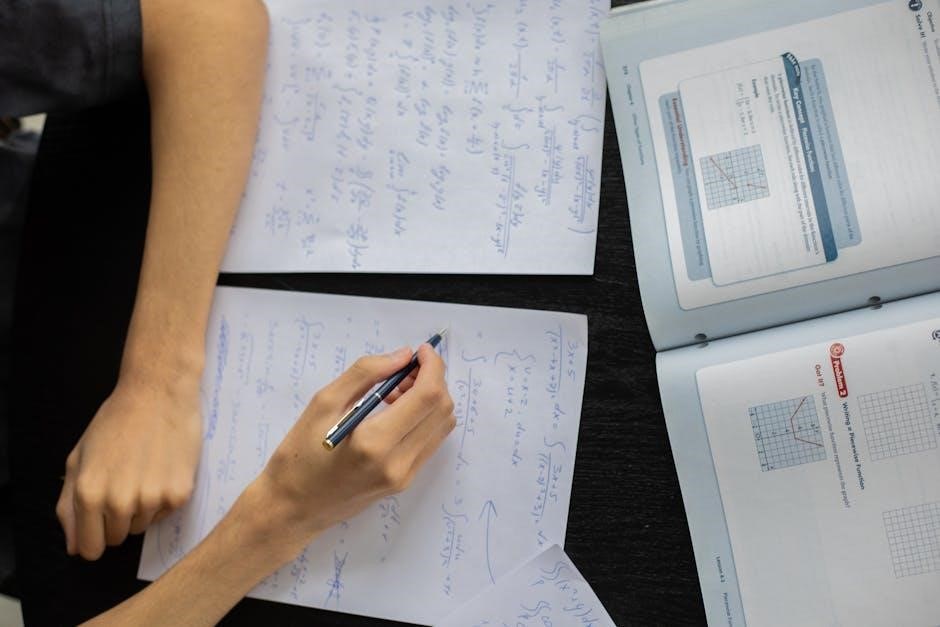Systems of linear equations word problems involve solving real-life scenarios using algebraic methods. They are essential for developing problem-solving skills and applying mathematics to practical situations effectively.
1.1. Definition and Importance
Systems of linear equations word problems involve solving real-world scenarios using algebraic methods. They are defined by their application of two or more equations to model practical situations. These problems are essential for developing problem-solving skills, as they bridge algebraic concepts with real-life contexts. Solving such problems enhances critical thinking and analytical abilities, making them a cornerstone in mathematics education and real-world applications.
1.2. Brief Overview of Linear Equations
A linear equation is an algebraic expression where variables are of the first degree, forming straight lines when graphed. They are fundamental in mathematics, representing constant rates of change. Linear equations are typically written as ax + by = c, where a, b, and c are constants. These equations model simple relationships between variables, making them the building blocks for solving systems of equations in word problems. They are essential for understanding more complex mathematical concepts.
1.3. Transition from Algebraic to Word Problems
Transitioning from algebraic equations to word problems involves interpreting narrative scenarios into mathematical expressions. This process requires identifying variables, translating words into equations, and ensuring the equations accurately represent the problem. Word problems often involve real-world contexts like money, mixtures, or travel, where systems of equations naturally arise. The key is to carefully read, define variables, and set up equations that reflect the relationships described in the problem, enabling practical application of algebraic concepts to solve real-life challenges effectively.

Common Types of Word Problems Solved by Systems of Equations
Systems of equations are used to solve various word problems, such as money, tickets, mixtures, distance, and work rate issues, by translating them into algebraic models effectively.
2.1. Money Problems
Money problems often involve calculating total costs, savings, or profits. For example, if Michael buys chips and pretzels for $5.13, systems of equations can determine the cost per item. These problems typically require identifying variables, setting up equations based on total value, and solving for unknowns. They are practical for real-life budgeting and financial planning, teaching how to allocate resources efficiently. Such scenarios are common in worksheets and examples, making them a fundamental application of systems of equations in everyday life.
2.2. Ticket Sales and Pricing
Ticket sales and pricing problems often involve determining the number of tickets sold at different prices to reach a total revenue. For example, a school selling senior citizen and regular tickets can use systems of equations to find the number of each ticket type sold. These problems require defining variables, setting up equations based on total revenue or attendees, and solving for unknowns. They are practical for understanding pricing strategies and event planning, making them a valuable application of systems of equations in real-world scenarios.
2.3. Mixture Problems
Mixture problems involve combining different substances or solutions to achieve a specific concentration or quantity. Systems of equations are used to determine the amount of each component needed. For instance, mixing two types of coffee to achieve a desired blend or combining chemicals to reach a specific concentration. These problems require defining variables for each component, setting up equations based on the total mixture, and solving for the unknown quantities. They are essential in fields like chemistry, cooking, and manufacturing, showcasing the practical application of systems of equations in everyday scenarios.
2.4. Distance and Travel Problems
Distance and travel problems involve scenarios where objects or people are moving toward or away from each other. These problems often require calculating meeting points, travel times, or speeds. Systems of equations are used to model the relationships between distance, speed, and time. For example, determining how long it takes for two trains to meet or calculating the speed of a boat traveling upstream versus downstream. These problems emphasize real-world applications of linear equations in logistics and transportation planning.
2.5. Work Rate Problems
Work rate problems involve determining how long it takes for individuals or machines to complete tasks together or separately. Systems of equations are used to model combined work rates. For example, if two people can paint a house together in 6 hours, but one can do it alone in 8 hours, equations help find the time the second person would take alone. These problems are common in labor and project management scenarios, emphasizing teamwork and efficiency through mathematical modeling.

Setting Up a System of Equations from Word Problems
Setting up a system of equations involves identifying variables, translating words into mathematical expressions, and formulating equations that model real-world scenarios accurately.
3.1. Identifying Variables
Identifying variables is the first step in setting up a system of equations from word problems. Variables represent unknown quantities, such as costs, quantities, or distances. They must be clearly defined based on the problem’s context. For instance, in a money problem, variables might represent the cost of an apple and the cost of a banana. Accurate identification ensures that the subsequent equations are relevant and solvable.
3.2. Translating Words into Mathematical Expressions
Translating words into mathematical expressions involves converting problem statements into algebraic equations. Key terms like “more than,” “twice,” or “total” signal operations or relationships. For example, “the sum of two numbers is 25” becomes ( x + y = 25 ). Understanding context ensures correct translation, such as interpreting “twice as many” as ( 2x ). This step is crucial for accurately representing the problem mathematically, enabling effective solving using systems of equations.
3.3. Formulating the System of Equations
Formulating a system of equations involves creating multiple equations based on the problem’s conditions. After identifying variables and translating words into expressions, the next step is to write two or more equations that relate these variables. For example, if a problem involves total cost and quantity, two equations might represent total items and total cost. Ensuring consistency in variables and equations is crucial for accurately representing the problem and enabling solvability.
Methods for Solving Systems of Linear Equations
Common methods include substitution, elimination, and graphical approaches. Each technique offers a structured way to find solutions, ensuring accuracy and efficiency in solving real-world problems.
4.1. Substitution Method
The substitution method involves solving one equation for a variable and substituting it into the other equation. This approach is particularly effective for systems where one equation can easily be solved for a variable; By isolating a variable in one equation, you can substitute its expression into the second equation, eliminating one variable and solving for the remaining one. This method is straightforward and works well for systems with clear, solvable equations.
4.2. Elimination Method
The elimination method eliminates one variable by adding or subtracting equations. By making coefficients equal, you can combine equations to eliminate a variable, solving for the remaining one. This method is efficient when variables have the same or opposite coefficients, simplifying the system. It’s especially useful for systems where substitution is less practical, providing a clear path to solutions in various word problems involving multiple variables and linear equations.
4.3. Graphical Method
The graphical method involves plotting the equations of a system on a coordinate plane. Each equation is graphed as a line, and the solution is found at their intersection point. This visual approach helps in understanding how the equations relate and provides a clear solution when the lines cross. While it is less precise for complex systems, it offers an intuitive way to solve word problems by transforming them into geometrical representations.

Real-World Applications of Systems of Equations
Systems of linear equations model real-world phenomena in economics, physics, engineering, and computer science, solving problems like supply and demand, motion, and network optimization.
5.1. Economics and Finance
In economics and finance, systems of linear equations are pivotal for analyzing market dynamics, such as supply and demand equilibrium, pricing strategies, and portfolio optimization. They help businesses and investors make informed decisions by modeling complex interactions between variables like cost, revenue, and market trends. For instance, determining optimal production levels or predicting economic trends can be efficiently solved using these systems, making them indispensable tools in financial planning and economic forecasting.
5.2. Physics and Engineering
Systems of linear equations are fundamental in physics and engineering for solving problems involving forces, velocities, and energies. They model complex systems, such as electrical circuits or structural loads, by breaking them into manageable equations. Engineers use these systems to optimize designs, analyze stress points, and ensure safety standards. Additionally, they aid in calculating trajectories in motion problems and resolving vector components, making them essential for precise and efficient problem-solving in technical fields.
5.3. Computer Science and Networking
Systems of linear equations are crucial in computer science and networking for tasks like algorithm optimization and network flow analysis. They enable the modeling of complex data relationships, such as routing protocols and bandwidth allocation; In machine learning, linear algebra underpins techniques like regression analysis. Networking relies on these systems to manage traffic patterns and ensure efficient data transmission. Solving such problems enhances computational efficiency and scalability in modern digital systems.
Resources for Practicing Word Problems
PDF worksheets, online tutorials, and interactive tools provide ample resources for practicing systems of linear equations word problems. Kuta Software and example-based guides are popular choices for honing skills in money, mixture, and travel-related problems.
6.1. PDF Worksheets and Examples
PDF worksheets and examples are widely available for practicing systems of linear equations word problems. These resources include step-by-step solutions and cover various scenarios like money, mixture, and travel problems. Worksheets often provide structured exercises, while examples demonstrate how to set up and solve equations for real-world situations. Popular resources include “Worksheet: Solving Word Problems Using Systems of Equations (Part 2)” and “Word Problems on Linear Equations with Solutions.” These tools are ideal for self-study and classroom use.
6.2. Online Tutorials and Videos
Online tutorials and videos provide interactive and visual learning experiences for mastering systems of linear equations word problems. Platforms like Khan Academy and Coursera offer step-by-step guides, while YouTube channels like 3Blue1Brown and Crash Course Math present engaging explanations. These resources cover topics like setting up equations from word problems and solving them using substitution or elimination methods. Videos often include real-world examples, such as budgeting or mixture problems, to illustrate practical applications.
Many websites, such as Math Antics and Brightstorm, offer free video lessons tailored for students. These tutorials are particularly helpful for visual learners and those who prefer self-paced learning. Additionally, some videos focus on common mistakes and how to avoid them, making them invaluable for reinforcing problem-solving skills.
6.3. Interactive Tools and Software
Interactive tools and software, such as Desmos Graphing Calculator and GeoGebra, offer dynamic ways to explore systems of linear equations word problems. These platforms allow users to input equations, visualize graphs, and manipulate variables in real-time. Tools like Kuta Software provide customizable worksheets and interactive exercises, enabling students to practice solving word problems independently. Additionally, software such as Mathway and Symbolab offer step-by-step solutions, helping learners understand how to set up and solve systems of equations effectively.

Best Practices for Solving Word Problems
Start by reading the problem carefully, identifying key details, and defining variables. Translate the words into mathematical expressions systematically. Solve the system methodically and verify the solution.
7.1. Reading and Understanding the Problem
Reading and understanding the problem is the first step in solving word problems. It involves identifying key information, such as quantities, relationships, and the unknowns. Carefully analyze each sentence to determine what is given and what needs to be found. Pay attention to specific details like total costs, numbers of items, or time durations. Misinterpreting the problem can lead to incorrect equations, so it is crucial to grasp the context and requirements fully before proceeding. This ensures that the variables and equations you set up accurately reflect the scenario described in the problem. Clear understanding leads to precise solutions.
7.2. Checking the Solution
Checking the solution is a critical step in ensuring accuracy. After solving the system of equations, substitute the values back into the original problem to verify they make sense. Ensure the solution satisfies all conditions and constraints described in the problem. For example, if the problem involves money or quantities, confirm the values are positive and realistic. Additionally, check the mathematical steps for any errors. This verification process helps catch mistakes early and builds confidence in the solution’s correctness. Regular checking improves problem-solving skills and reduces errors over time.
7.3. Avoiding Common Mistakes
Common mistakes in solving systems of linear equations word problems include misdefining variables, incorrect translations of words into equations, and arithmetic errors. To avoid these, carefully read the problem, define variables clearly, and double-check each step. Ensure the equations logically represent the scenario and verify solutions by substituting them back into the original problem. Practicing with examples and using resources like worksheets or online tutorials can help minimize errors and improve problem-solving accuracy over time.
Systems of linear equations word problems are a powerful tool for solving real-world scenarios, offering practical applications in various fields; By mastering these problems, individuals can enhance their analytical and problem-solving skills. Utilizing resources like PDF worksheets and online tutorials provides ample opportunities for practice and improvement. Regular application of these methods ensures proficiency, making systems of linear equations an indispensable skill in both academic and professional settings. Embrace these resources to refine your expertise and tackle complex challenges with confidence.